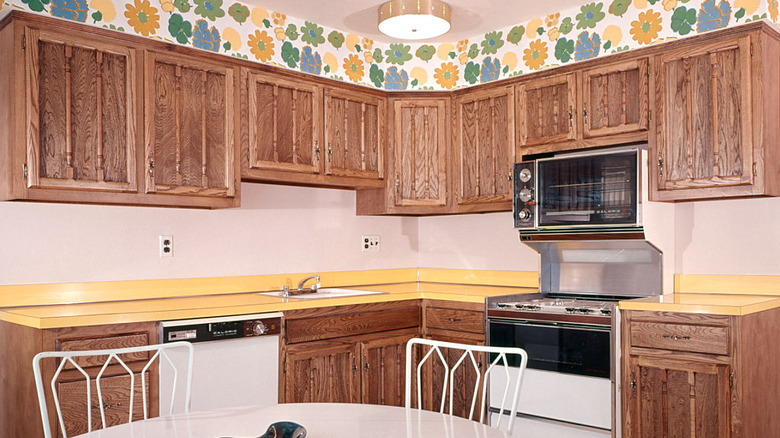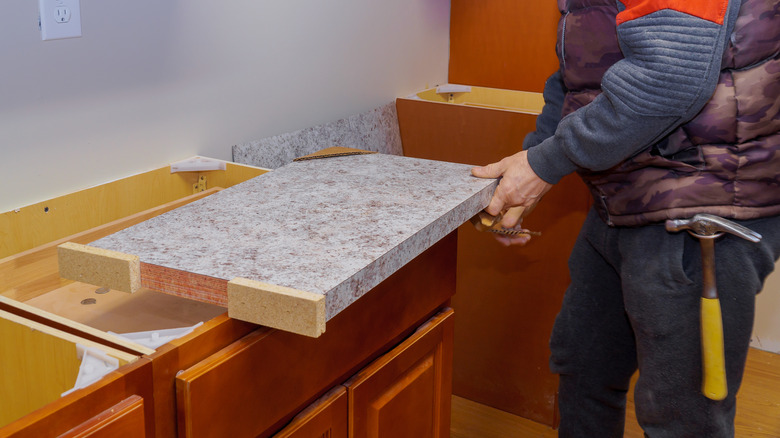If You Had These Kitchen Countertops As A Kid, You Probably Grew Up In The '70s
When it comes to decor, you know you're from the '70s if your kitchen had certain things. One telltale design feature characteristic of the era was those Formica countertops that were literally everywhere. If your childhood breakfasts were eaten on a shiny, lacquered, brightly colored kitchen counter, you were probably a kid of the '70s.
Formica was actually just one brand name among various makers of laminate countertops, but the word became synonymous with all countertops of that kind. The Formica counters of the '70s — like most of the decor of the time — centered on nature-esque colors, with the leading hues being avocado green, a mustardy yellow (commonly known as harvest gold), oranges, and browns. Laminate countertops with woodgrain patterns also came into vogue.
Any household that experienced a renovation during this decade (or undertook the construction of a new home) was generally awash in these colors and almost certainly had laminate on every counter surface. Fast-forwarding to the modern day, if you've ever gone on a house hunt for a new abode, you may have encountered one of those "time capsule" homes that has never been touched by a renovation since the day it was built. Since these houses are cosmetically frozen in time, touring one can be a fascinating — if sometimes a bit unsightly — trip into the past, and brightly colored Formica countertops definitely feature prominently.
The rise and fall of Formica
Before Formica and other laminates came along, typical kitchen work surfaces were constructed of wood, with materials like marble and metal appearing in wealthier households. Natural stone surfaces began appearing more abundantly in the late 1800s. It wasn't until the 1950s that laminates began to enter the scene.
Some of the features that made laminate countertops, including the Formica brand, so popular in their day were the ease with which they could be cleaned and their resistance to cigarette damage (in addition to being the age of Formica, the 1950s, '60s, and '70s were also the ages of smoking). The versatility of these surfaces in terms of color and pattern was also highly attractive. By the 1970s, the ability to get those coveted '70s colors on one's culinary surfaces made laminates a must-have commodity for modern households.
Laminates weren't perfect, though, and over time their defects became apparent. The material was prone to staining, scratching, and other damage. One of the very attributes that had made it popular — the option of having those distinctive retro colors and patterns — also spurred the material's decline. As those vivid, lacquered oranges and greens went out of fashion, they couldn't simply be painted over like a wall. Homeowners had to remove them if they wanted to keep their kitchens on trend, and they frequently opted to replace laminate with the natural stone options that were becoming more popular.
What goes around comes around in countertops
While Formica countertops have become a retro feature, we should remember that what's popular now won't necessarily be in demand in a decade. For instance, granite countertops were a hot design commodity in the 1990s and 2000s that we thought would last forever, but in the modern debate of granite versus quartz, the latter has gained traction both in popularity and perceived value.
However, even as styles fall out of favor, they tend to come back around. Though laminate counters waned in favor, the material is becoming stylish once more among Millennials and Gen Z homeowners. Consumers of these generations, just like those of the earlier era, are being drawn to the affordability of laminate as well as its versatility in terms of color, pattern, and style.
Laminate countertop products have come a long way since the mid-20th century. The Formica company is still very much in business, and laminates in general can be customized to mimic virtually any natural stone or other product, thanks to technological advances. Today's laminate countertops are also much more durable than those of yesteryear.
But while laminate countertops are once again being installed in kitchens across the land, they're still not everybody's cup of tea. For HGTV power duo the Property Brothers, for instance, laminates are the countertops to avoid. The famous design twins prefer the real thing in a countertop — stone, butcher block, etc. — rather than an imitation merely printed to look like the real thing.



